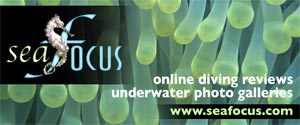- Home
- Directory
- Shop
- Underwater Cameras - Photographic Accessories
- Smartphone Housings
- Sea Scooters
- Hookah Dive Systems
- Underwater Metal Detectors
- Dive Gear
- Dive Accessories
- Diving DVD & Blu-Ray Discs
- Diving Books
- Underwater Drones
- Drones
- Subscriptions - Magazines
- Protective Cases
- Corrective Lenses
- Dive Wear
- Underwater Membership
- Assistive Technology - NDIS
- On Sale
- Underwater Gift Cards
- Underwater Art
- Power Stations
- Underwater Bargain Bin
- Brands
- 10bar
- AOI
- AquaTech
- AxisGo
- Backscatter Underwater Video and Photo
- BLU3
- Cayago
- Chasing
- Cinebags
- Digipower
- DJI
- Dyron
- Edge Smart Drive
- Eneloop
- Energizer
- Exotech Innovations
- Fantasea
- Fotocore
- Garmin
- Geneinno
- GoPro
- Hagul
- Hydro Sapiens
- Hydrotac
- Ikelite
- Indigo Industries
- Inon
- Insta360
- Intova
- Isotta Housings
- Jobe
- JOBY
- Kraken Sports
- LEFEET
- Mirage Dive
- Nautica Seascooters
- Nautilus Lifeline
- NautiSmart
- Nitecore
- Nokta Makro
- Oceanic
- Olympus
- OM System
- Orca Torch
- Paralenz
- PowerDive
- QYSEA
- Scubajet
- Scubalamp
- Sea & Sea
- SeaDoo Seascooter
- SeaLife
- Seavu
- Shark Shield
- Sherwood Scuba
- Spare Air
- StickTite
- Sublue
- Suunto
- SwellPro
- T-HOUSING
- Tusa
- U.N Photographics
- Venture Heat
- XTAR
- Yamaha Seascooter
- Youcan Robot
Diving Papua New Guinea - New Ireland
Contributed by Chris Bartlett
Text and Images by Christopher Bartlett
Is there another country anywhere with so much diversity? The six million inhabitants of this nation of mountains and islands are spread over 463,000 km2 of mountainous tropical forests, and speak over 800 different languages (12% of the world total). Papua New Guinea occupies half of the third largest island in the world and 160 other islands and 500 named cays.
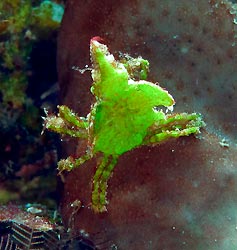 Located just south of the equator and to the
north of Australia, PNG
is a diver's paradise with the 4th largest surface area of coral reef
ecosystem in the world (40,000 km2 of reefs, seagrass beds, and
mangroves in 250,000 km2 of seas), and underwater diversity
with 2500 species of fish, corals, and molluscs. There are more dive
sites than you can shake a stick at, with many more to be discovered,
and barely a diver on them. The dive centres are so far apart that
there is only ever one boat at any dive site.
Located just south of the equator and to the
north of Australia, PNG
is a diver's paradise with the 4th largest surface area of coral reef
ecosystem in the world (40,000 km2 of reefs, seagrass beds, and
mangroves in 250,000 km2 of seas), and underwater diversity
with 2500 species of fish, corals, and molluscs. There are more dive
sites than you can shake a stick at, with many more to be discovered,
and barely a diver on them. The dive centres are so far apart that
there is only ever one boat at any dive site.
It is one of the few places left in the world where a diver can see macro critters, pelagics, and big stuff, as well as fantastic soft and hard corals. The often misused and abused adjective “pristine” is actually appropriate here, due to low fishing pressure in the area in comparison to other areas of the Coral Triangle, no dynamite fishing, and thanks to a system implemented by dive resorts whereby local reef "owners" receiving a small fee for every diver that visits "their" reef. As a result elders make sure that the reefs are not fished.
So, where to go? We set of on a four-resort tour to the north and
the south taking in the provinces of Oro, New Ireland and Milne
Bay. Read below the second instalment of this story. Part I
covers Oro, and Part III Milne Bay and the Annual Goroka Cultural
Festival.
NEW IRELAND
Two hours’ flight north-east of Port Moresby,
with a 10-minute stop
in West New Britain near the site of Papua New Guinea’s last volcanic
eruption, lies
Kavieng, the capital of New Ireland province. Located at the northern
tip of a 380-kilometre long island, sleepy Kavieng and its 11,000
inhabitants hold few attractions for most of the trickle of tourists
who venture here to dive and to surf and no accommodation worth staying
in. 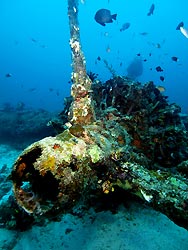 Yet if you like wandering around
dusty betel nut-stained streets
and dim and musty shops, an afternoon in town after a dive is an
interesting experience and was another opportunity to experience the
friendly nature of the locals.
Yet if you like wandering around
dusty betel nut-stained streets
and dim and musty shops, an afternoon in town after a dive is an
interesting experience and was another opportunity to experience the
friendly nature of the locals.
New Ireland’s diving has a reputation for pelagics and sharks that
are attracted by the fresh deep water that is flushed between the
multitude of small islands and passages making up the area
Dogtooth Tuna, Spanish Mackerel, trevally, and Barracuda, and
Black-tip, White-tip, Silvertip, and Grey Reefsharks all came out to
play. New Ireland also has a good mixture of vibrant and colourful
reefs, a few interesting muck-diving sites, and WW2 plane wrecks
aplenty.
Dorian Borcherds, joint-owner of Kavieng Scuba Ventures, has a
wealth of knowledge of both the Japanese and Allied planes found in the
area. Picking us up from the doorstep of our villa on the water’s edge,
under the palm trees at Nusa Island Retreat opposite Kavieng harbour in
the morning, he and his wife Cara took us to sites in both the Bismarck
Sea and South Pacific Ocean. 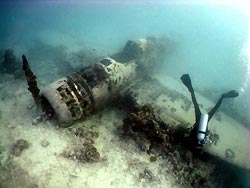 Some of the South Pacific sites
such as
the trevally and anemone festooned Echuka Patch and the Der Yang
shipwreck were less than a ten-minute putter away. The Japanese Pete
and Jake float planes, stationed here when Kavieng was under wartime
occupation, were so close we’d arrived before we could kit up, as were
the remains of a Catalina flying boat and several unexploded bombs.
Some of the South Pacific sites
such as
the trevally and anemone festooned Echuka Patch and the Der Yang
shipwreck were less than a ten-minute putter away. The Japanese Pete
and Jake float planes, stationed here when Kavieng was under wartime
occupation, were so close we’d arrived before we could kit up, as were
the remains of a Catalina flying boat and several unexploded bombs.
The Bismark Sea sites were a little further, closer to half-an-hour
away, but are well worth the trip through the islands and mangroves.
Albatross Passage has stunning soft coral coverage and a wide range of
fish, with Pygmy Seahorses, cuttlefish, Dogtooth Tuna and sharks. On an
incoming tide it is a truly excellent dive, down by the wall and on the
sandy shelf it is calm but ends with a safety stop on reef hooks
watching the action below as the current pumps past. 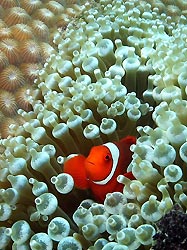 On the way back
the B-25 Stubborn Hellion awaits in 12 metres of water on the edge of
the mangroves. Sixty-eight years after crashing into the sea after
sustaining damage in a bombing raid on Kavieng, she is in remarkably
good condition, with a Spine-cheek Anemonefish manning the
twin-machineguns in the top aft turret. The current can also adversely
affect visibility on occasion, and we caught what was described by both
dive centres as unusually poor viz. It is all relative though, and a
measure of how good it usually is; the very worst we had was 15 metres!
On the way back
the B-25 Stubborn Hellion awaits in 12 metres of water on the edge of
the mangroves. Sixty-eight years after crashing into the sea after
sustaining damage in a bombing raid on Kavieng, she is in remarkably
good condition, with a Spine-cheek Anemonefish manning the
twin-machineguns in the top aft turret. The current can also adversely
affect visibility on occasion, and we caught what was described by both
dive centres as unusually poor viz. It is all relative though, and a
measure of how good it usually is; the very worst we had was 15 metres!
Dorian is a positively affable chap with a fun sense of humour, a John Holmes moustache, and will, at some point, have you laughing till your mask fills and you can barely keep your reg in, but takes his diving seriously. It was only after we’d been diving together for three days that he asked if I’d like to do an afternoon freshwater cave dive half an hour inland. You bet! Despite having well over a 1000 dives in my logbook, I’d never done a penetration dive, so was a touch nervous as we clambered carefully down inside the mouth of a cavern.
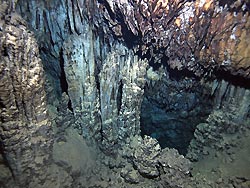 With two torches each, we carefully
slipped into what appeared to be
nothing much more than a large puddle, mindful of not disturbing the
fine silt on the bottom, and followed an orange safety line down and
in. After an initially narrow section we emerged into a series of huge
caverns draped in stalactites and stalagmites full of gin clear water,
only troubled by the odd halocline. The environment and total stillness
were enthralling in their own right, but it was even more
thought-provoking with the knowledge that the water level was once much
lower and the caves surely inhabited. Close to the entrance and exit,
in six metres of water, lie the remains of Japanese rice bowls and a
clay bottle made in the late 1800’s in the Netherlands. It begs the
question what older relics might lay further in.
With two torches each, we carefully
slipped into what appeared to be
nothing much more than a large puddle, mindful of not disturbing the
fine silt on the bottom, and followed an orange safety line down and
in. After an initially narrow section we emerged into a series of huge
caverns draped in stalactites and stalagmites full of gin clear water,
only troubled by the odd halocline. The environment and total stillness
were enthralling in their own right, but it was even more
thought-provoking with the knowledge that the water level was once much
lower and the caves surely inhabited. Close to the entrance and exit,
in six metres of water, lie the remains of Japanese rice bowls and a
clay bottle made in the late 1800’s in the Netherlands. It begs the
question what older relics might lay further in.
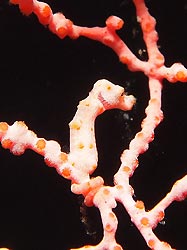 As well as being home to Nusa Island Retreat,
Big Nusa is inhabited
by a local community who chat happily with visitors taking a walk
around the island. During the windy months from October to March the
multitude of small islands and channels are dotted with apparently
excellent surf breaks and the accommodation often taken up by surfers,
the owner Sean being a keen wave rider himself, as well as the provider
of a good yarn and even better tucker. He also likes a party, and night
owls will feel at home.
As well as being home to Nusa Island Retreat,
Big Nusa is inhabited
by a local community who chat happily with visitors taking a walk
around the island. During the windy months from October to March the
multitude of small islands and channels are dotted with apparently
excellent surf breaks and the accommodation often taken up by surfers,
the owner Sean being a keen wave rider himself, as well as the provider
of a good yarn and even better tucker. He also likes a party, and night
owls will feel at home.
The other accommodation option is Lissenung Island, an even smaller
island twenty minutes boat ride towards the Bismarck Sea. Owned by
Austrian ex-engineer Dietmar Amon and his wife Ange, it’s seven rooms
are ideally located for diving the Bismarck sites like Peter’s Patch
and its batfish and pelagics, Helmut’s Reef, the Leaf Fish and
White-bonnet Anemonefish at Danny’s Bommy, the long wall at Kavin II,
Matrix and its whip and soft branching coral, and of course Albatross.
They are all excellent sites with varied topography, amazing tiny
critters like Halemeda and Orang-utan Crabs, abundant Longnose
Hawkfish, schools of one-metre Humphead Parrotfish, more Pygmy
Seahorses, tiny crinoid-dwelling Squat Lobsters and Horned Shrimps, 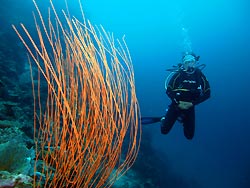 and
Panda Anemonefish. We dived some of them several times, and would
happily return to them repeatedly, although if a choice had to be made
Albatross and its wall overgrown with big fan corals, black corals and
sponges just pips the others.
and
Panda Anemonefish. We dived some of them several times, and would
happily return to them repeatedly, although if a choice had to be made
Albatross and its wall overgrown with big fan corals, black corals and
sponges just pips the others.
Several times a year Lissenung’s twin-engined 26-foot Ozycat heads northwards to New Hanover on expeditions to explore virgin reefs, a Japanese two-man submarine, and Chapman’s reef and its resident giant groupers, staying in guesthouses on different islands depending on the itinerary.
Contrary to Nusa, Lissenung Island is only occupied by the seven-room resort, has a “no guests under 12” policy, and can be walked around in ten minutes. Basically guests share Dietmar and Ange’s private island paradise, with sandy and well-kept gardens, a small but perfect white sand beach with several seahorses basking in the shallows, and each room facing the sea.
The staff live on the neighbouring island of Enuk, and tours can be
arranged to the village and school, whose development 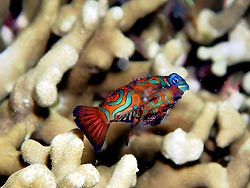 that the
philanthropic owners have been heavily involved in. In the evening the
office doubles up as a clinic as locals come in to have a variety of
minor injuries dealt with.
that the
philanthropic owners have been heavily involved in. In the evening the
office doubles up as a clinic as locals come in to have a variety of
minor injuries dealt with.
The usual routine sees the dive boat leave
after breakfast and return for lunch. It doesn’t take
too much luck to get a glimpse of juvenile Black-tip Reef Sharks around
the far side of the island.
Afternoon and dusk dives leave
daily, and a secret location is home to more Mandarinfish mating after
sunset. Afternoon dives on the house reef that goes two-thirds of the
way around the island are free, and much of the best stuff is in three
metres of water, making it ideal for snorkelling too.
Shopfront
-
 Kraken Remote Control RC02
Kraken Remote Control RC02
- Price A$ 379.00
-
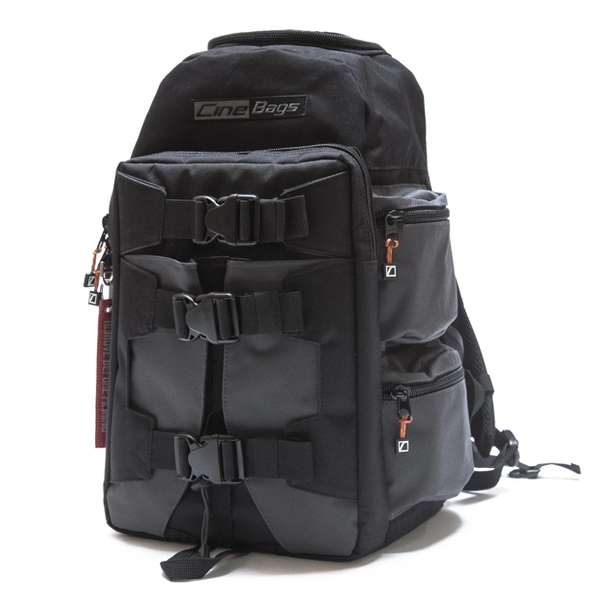 CineBags - CB23 DSLR Backpack
CineBags - CB23 DSLR Backpack
- Price A$ 405.95
-
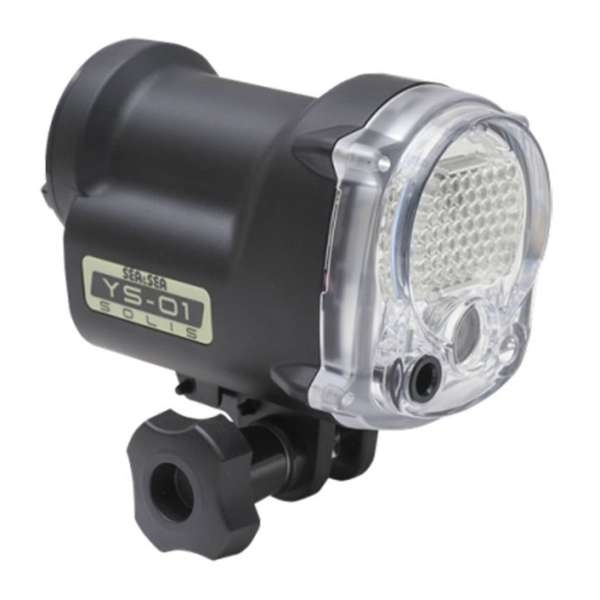 Sea & Sea YS-01 SOLIS Strobe head
Sea & Sea YS-01 SOLIS Strobe head
- Price A$ 739.00
-
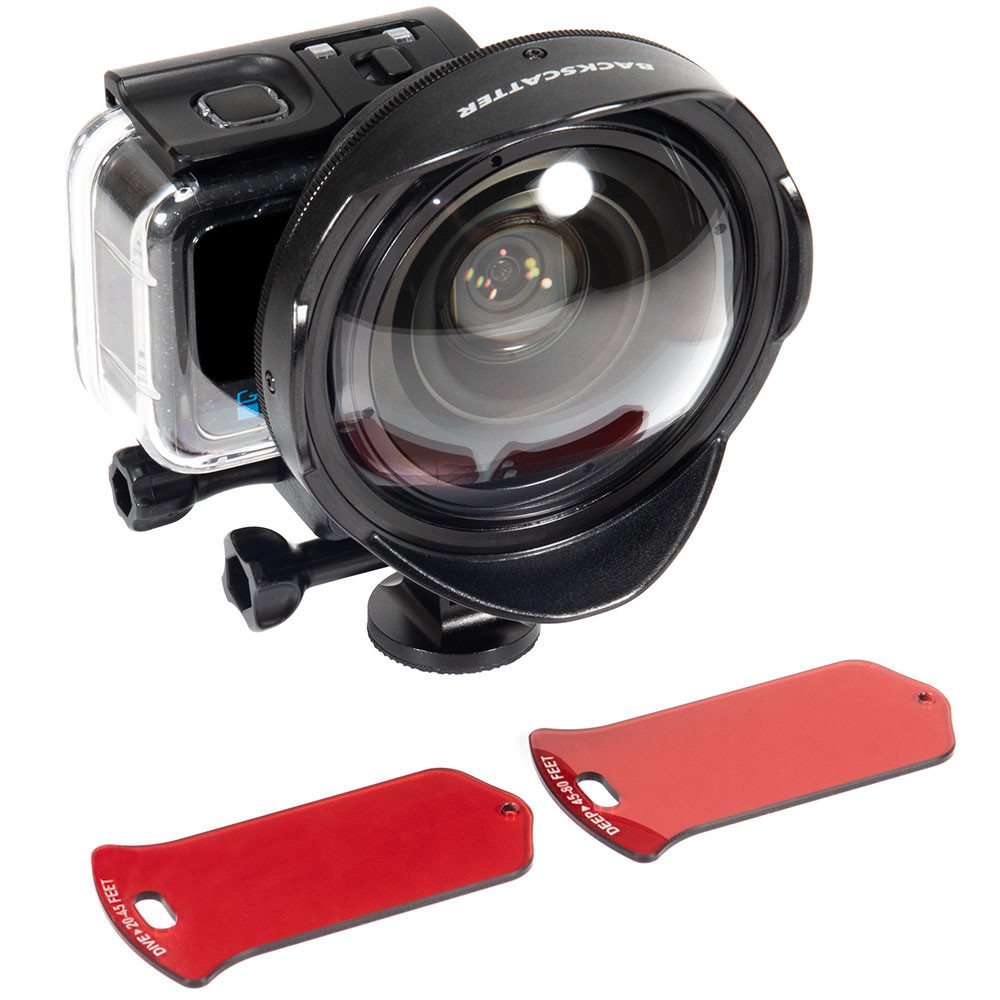 Backscatter Sharp Wide Lens Pro Package for GoPro
Backscatter Sharp Wide Lens Pro Package for GoPro
- Price A$ 419.00
-
 Fotocore M15 PRO Photo/Video Light - 15,000 lumens
Fotocore M15 PRO Photo/Video Light - 15,000 lumens
- Price A$ 1,999.00
-
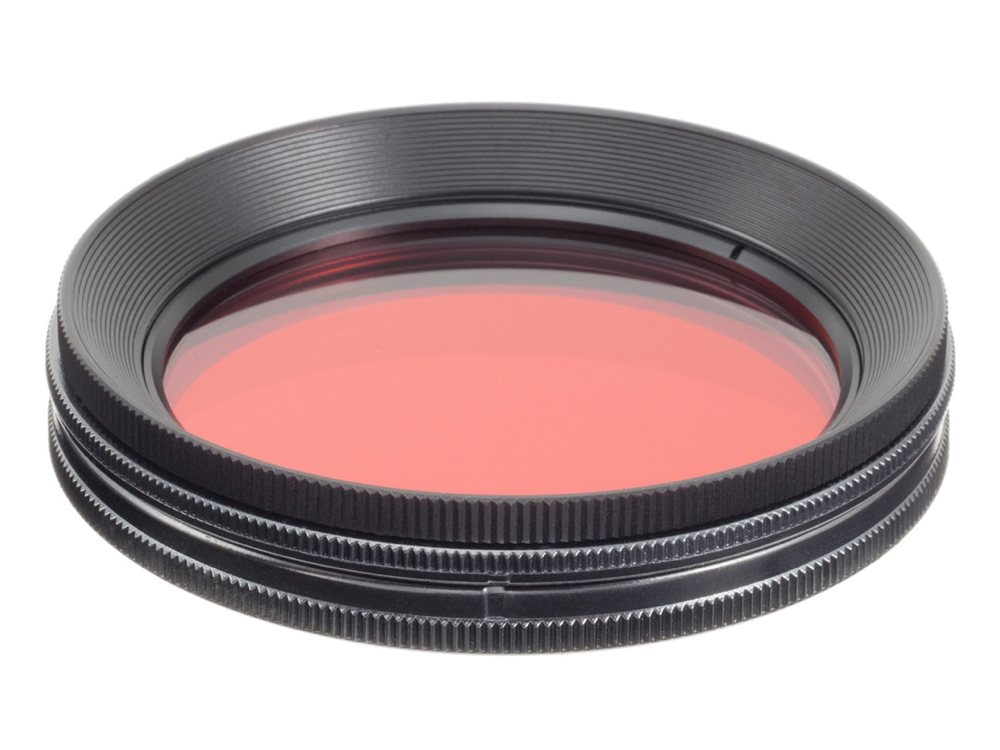 Inon UW Variable Red Filter M67
Inon UW Variable Red Filter M67
- Price A$ 239.95
-
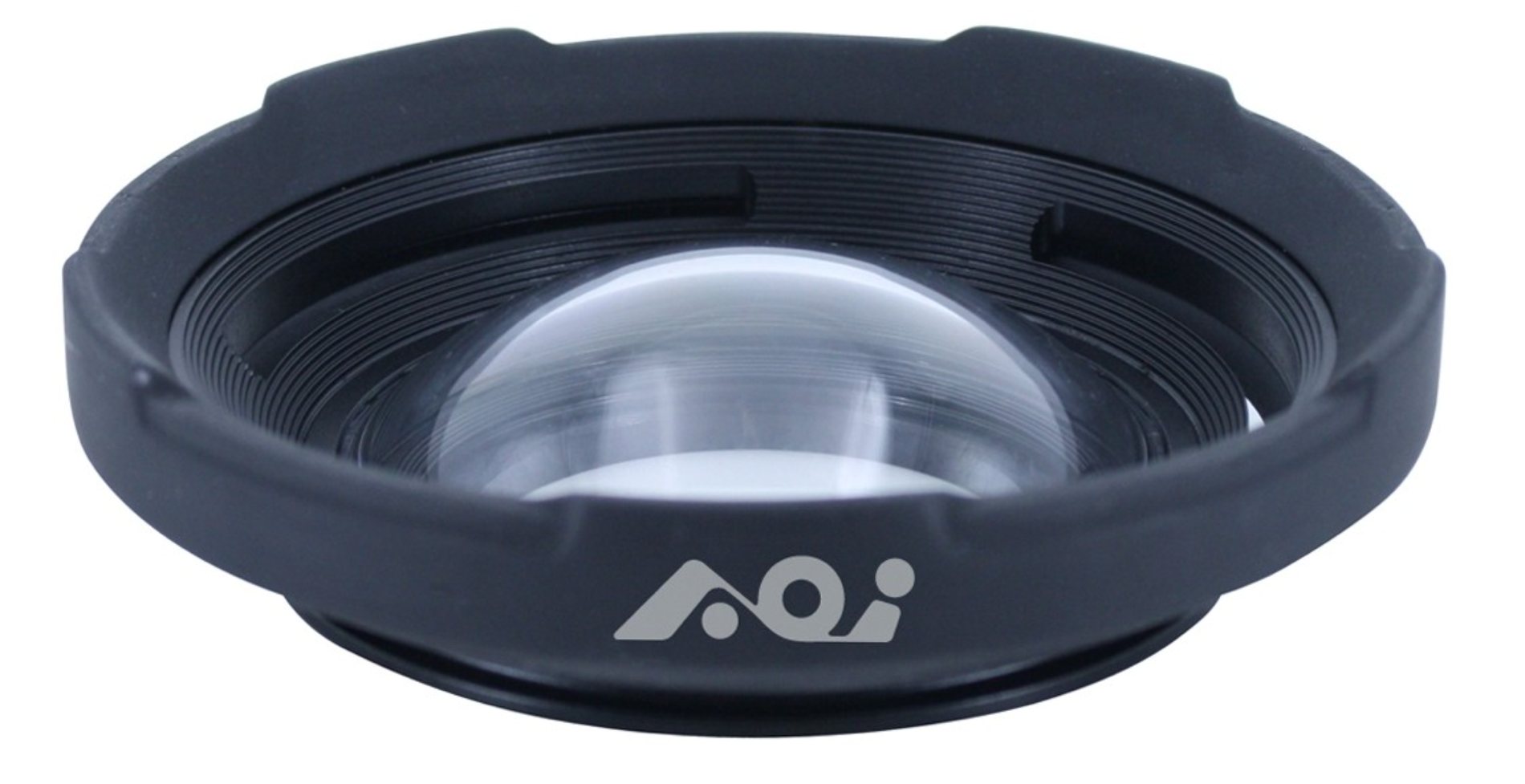 AOI Wide Angle Air Lens M52 Mount
AOI Wide Angle Air Lens M52 Mount
- Price A$ 254.95
In the Directory



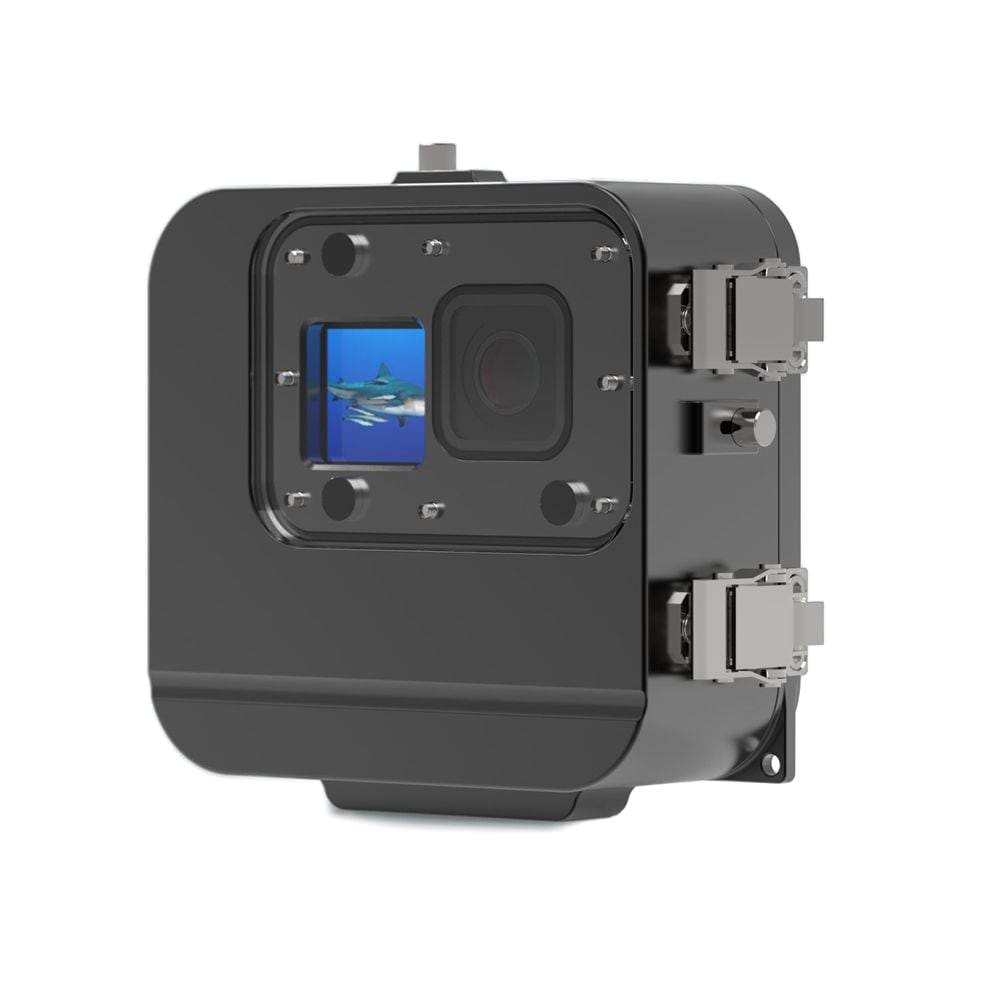
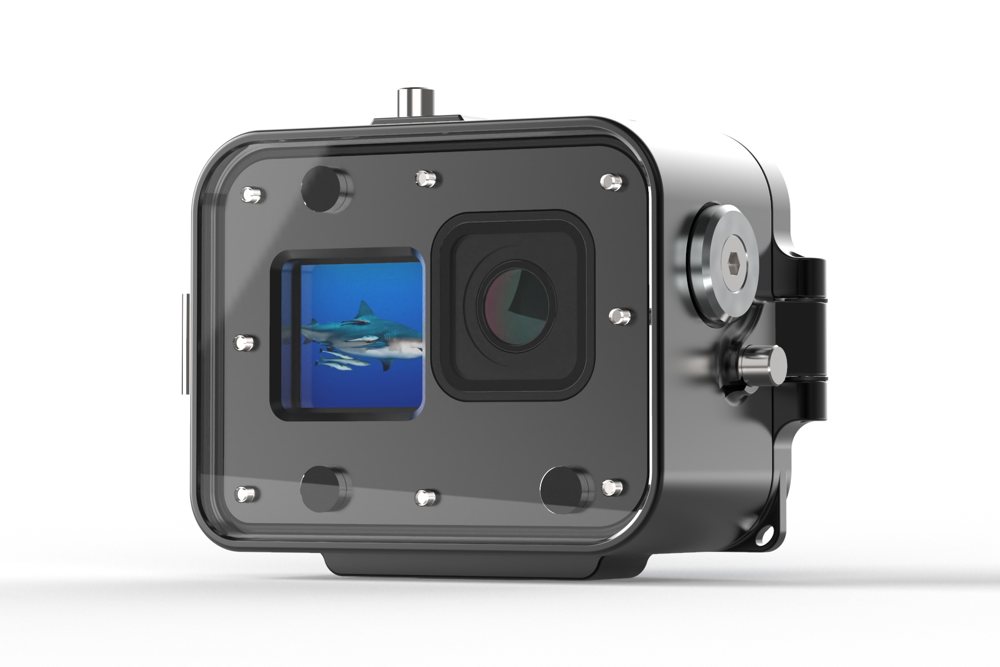
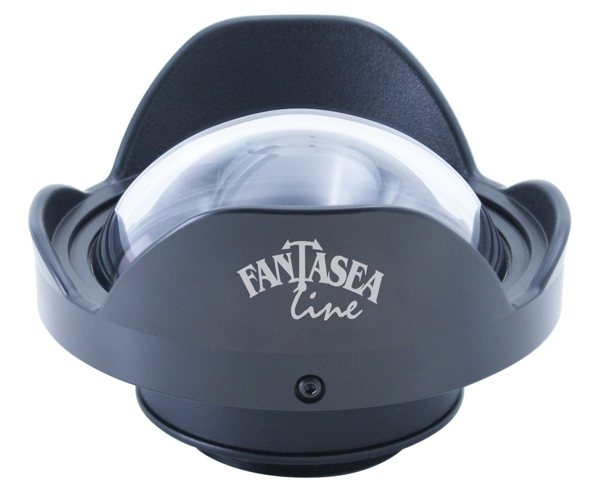

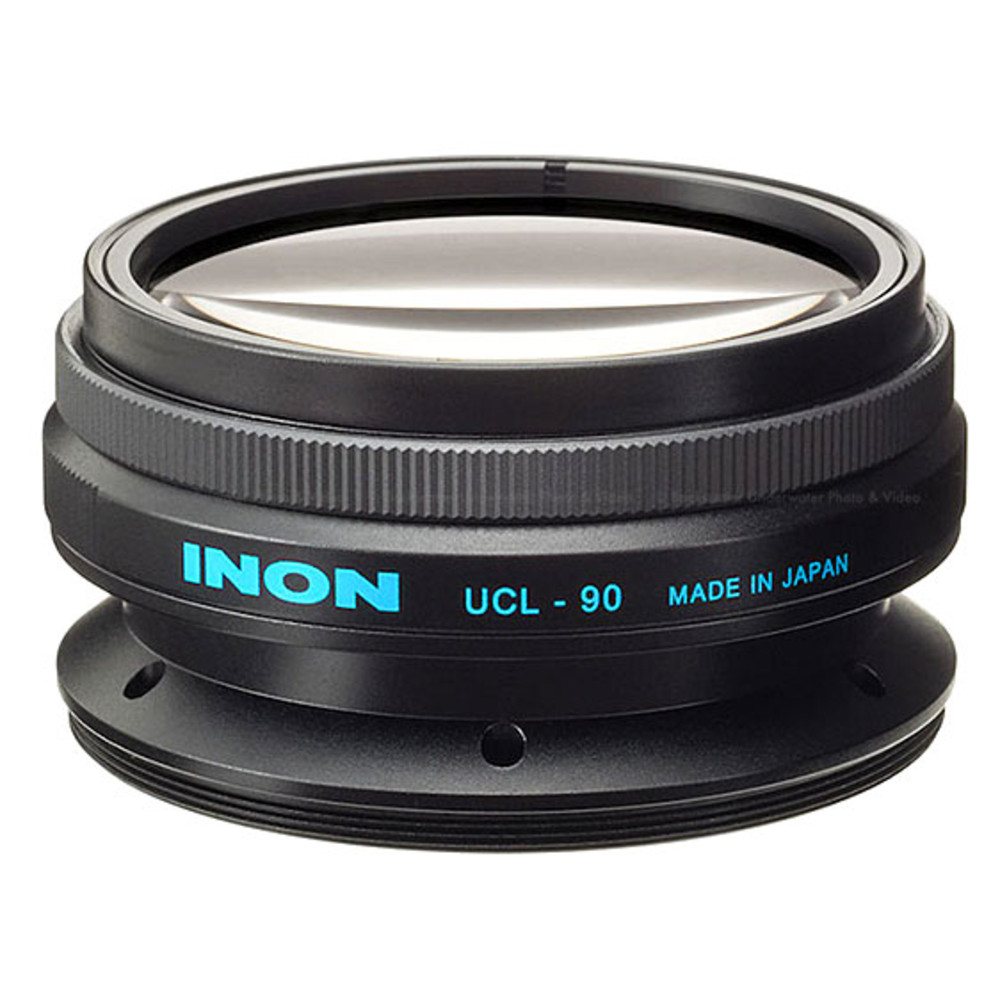

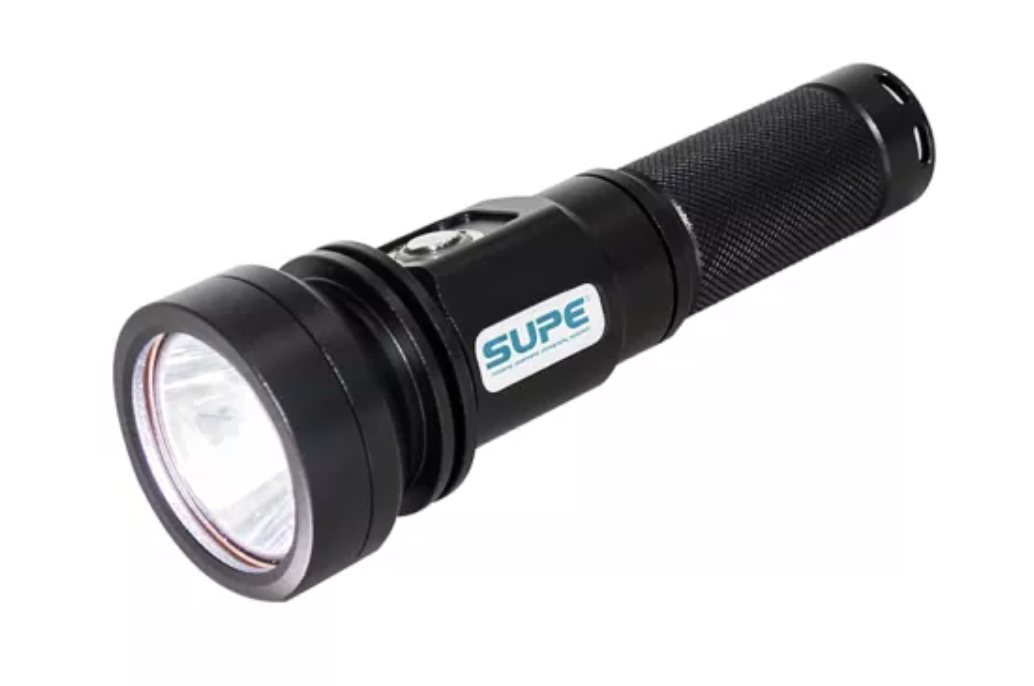




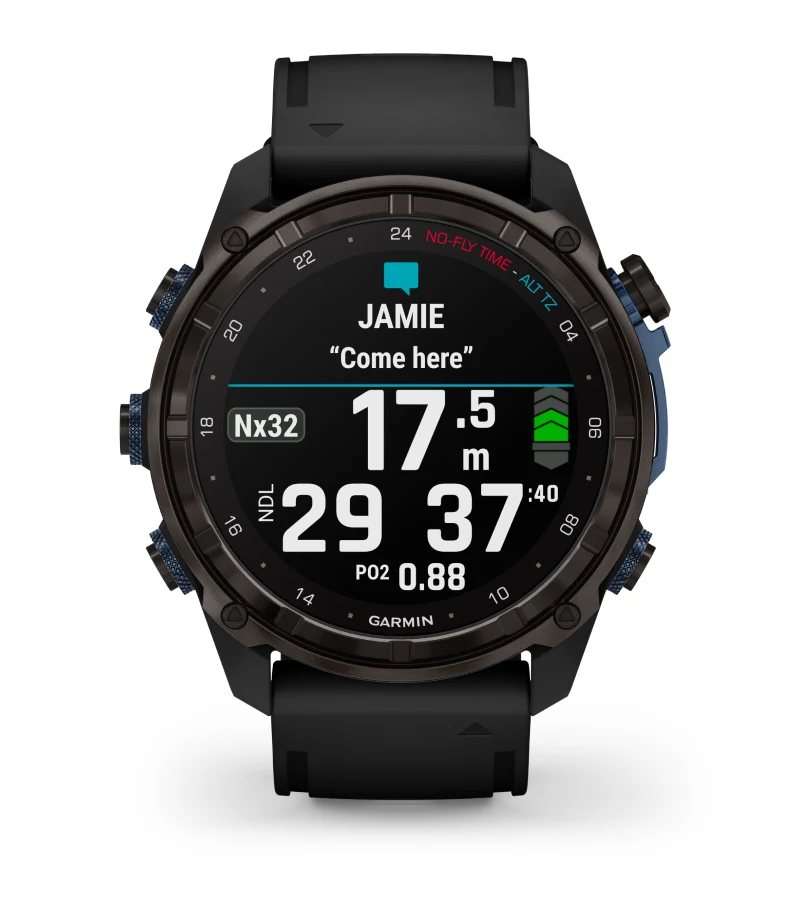 Garmin Descent Mk3i Watch Dive Computer - 51 mm, Carbon grey DLC titanium
Garmin Descent Mk3i Watch Dive Computer - 51 mm, Carbon grey DLC titanium 



